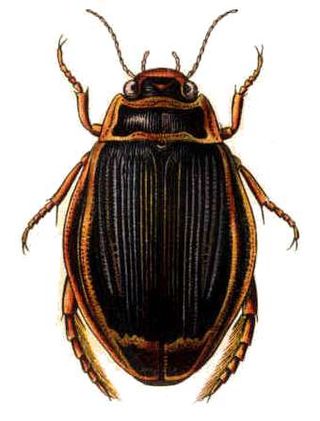
Dytiscus is a Holarctic genus of predaceous diving beetles that usually live in wetlands and ponds. There are 26 species in this genus distributed in Europe, Asia, North Africa and North and Central America. They are predators that can reduce mosquito larvae.
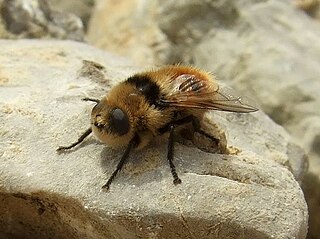
Botflies, also known as warble flies, heel flies, and gadflies, are a family of flies known as the Oestridae. Their larvae are internal parasites of mammals, some species growing in the host's flesh and others within the gut. Dermatobia hominis is the only species of botfly known to parasitize humans routinely, though other species of flies cause myiasis in humans.

Gasterophilus, commonly known as botfly, is a genus of parasitic fly from the family Oestridae that affects different types of animals, especially horses, but it can also act on cows, sheep, and goats. A case has also been recorded in a human baby.

Ceratomia catalpae, the catalpa sphinx, is a hawk moth of the family Sphingidae. The species was first described by Jean Baptiste Boisduval in 1875. Other common names are the Catawba worm, or Catalpa sphinx.

Myiasis, also known as flystrike or fly strike, is the parasitic infestation of the body of a live animal by fly larvae (maggots) that grow inside the host while feeding on its tissue. Although flies are most commonly attracted to open wounds and urine- or feces-soaked fur, some species can create an infestation even on unbroken skin and have been known to use moist soil and non-myiatic flies as vector agents for their parasitic larvae.

Hyalophora cecropia, the cecropia moth, is North America's largest native moth. It is a member of the family Saturniidae, or giant silk moths. Females have been documented with a wingspan of five to seven inches or more. These moths can be found all across North America as far west as Washington and north into the majority of Canadian provinces. Cecropia moth larvae are most commonly found on maple trees, but they have also been found on cherry and birch trees among many others. The species was first described by Carl Linnaeus in his 1758 10th edition of Systema Naturae.

Danaus chrysippus, also known as the plain tiger, African queen, or African monarch, is a medium-sized butterfly widespread in Asia, Australia and Africa. It belongs to the Danainae subfamily of the brush-footed butterfly family Nymphalidae. Danainae primarily consume plants in the genus Asclepias, more commonly called milkweed. Milkweed contains toxic compounds, cardenolides, which are often consumed and stored by many butterflies. Because of their emetic properties, the plain tiger is unpalatable to most predators. As a result, its coloration is widely mimicked by other species of butterflies. The plain tiger inhabits a wide variety of habitats, although it is less likely to thrive in jungle-like conditions and is most often found in drier, wide-open areas.

Citheronia regalis, the regal moth or royal walnut moth, is a North American moth in the family Saturniidae. The caterpillars are called hickory horned devils. The adult (imago) has a wingspan of 3.75–6.1 in (9.5–15.5 cm). The species was first described by Johan Christian Fabricius in 1793.

Cobboldia is a genus of parasitic flies in the family Oestridae. Adult flies of Cobboldia elephantis lay their eggs near the mouth or base of the tusks of Asian elephant while the related Cobboldia loxodontis parasitizes African elephants. The larvae hatch and develop in the mouth cavity and later move to the stomach. On maturing, the third instar larvae exit from the mouth and drop to the ground to pupate.
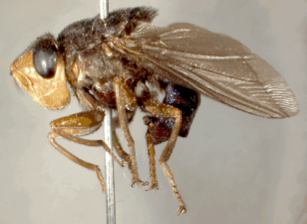
The human botfly, Dermatobia hominis, is a species of botfly whose larvae parasitise humans. It is also known as the torsalo or American warble fly, though the warble fly is in the genus Hypoderma and not Dermatobia, and is a parasite on cattle and deer instead of humans.
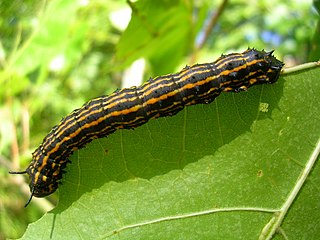
Anisota senatoria, the orangestriped oakworm, also known as the orange-tipped oakworm, is a Nearctic moth of the family Saturniidae and subfamily Ceratocampinae. It is one of the more common Saturniids, reaching pest status occasionally in the northern parts of its range. As they are late-season feeders, however, they do little lasting damage to their hosts. It is very similar to A. finlaysoni in southern Ontario and A. peigleri in the southern US. The species was first described by James Edward Smith in 1797.

Gyrostigma is a genus of botfly which parasitize rhinoceroses. The best-known species is Gyrostigma rhinocerontis, the rhinoceros stomach botfly, which develops in the stomach lining of the black rhinoceros and white rhinoceros of Africa, and the adult of which is the largest fly known in Africa.

Chrysomya is an Old World blow fly genus of the family Calliphoridae. The genus Chrysomya contains a number of species including Chrysomya rufifacies and Chrysomya megacephala. The term “Old World blow fly” is a derivative of both the associated family, Calliphoridae, and the belief that the genus Chrysomya originated in Asia and migrated to North America only relatively recently. Chrysomya’s primary importance to the field of medico-criminal forensic entomology is due to the genus’ reliable life cycle, allowing investigators to accurately develop a postmortem interval. Chrysomya adults are typically metallic colored with thick setae on the meron and plumose arista. The name comes from the word chrysos, meaning “golden” in reference to the metallic sheen of the genus’ species, and -mya, a derivation from the word myia, meaning “fly”.

Lebia grandis is a ground beetle in the family Carabidae found in North America. It is a specialist predator on the eggs and larvae of Colorado potato beetles, and its larvae are obligate parasitoids of Colorado potato beetle pupae.
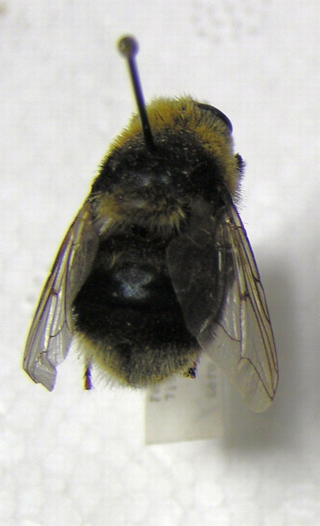
Cephenemyia ulrichii or the moose botfly, also called the elk botfly, moose nose botfly or moose throat botfly, is a large botfly that resembles a bumblebee. In the wild, they attack chiefly the nostrils and pharyngeal cavity of moose, but have been found in other deer species. There have also been several cases of C. ulrichii squirting their larvae into the eyes of human beings, a somewhat painful event that requires medical attention to forestall any possibility of serious damage.

Oestrus ovis, the sheep bot fly, is a widespread species of fly of the genus Oestrus. It is known for its parasitic predation and damage to sheep, deer, goats and sometimes cattle. There have also been many records of horse, dog and human infestation. In some areas of the world it is a significant pest which affects the agricultural economy.

Hemileuca lucina, the New England buck moth, is a species of moth in the family Saturniidae. This moth species is only found in the New England region of the United States. Larvae in early stages mainly feed on broadleaf meadowsweet whereas larvae in later stages show variation in food sources such as blackberry and black cherry leaves. Larvae have a black body with orange/black spines on their back that are used to deter predators. Pupation occurs during the summer and adult moths come out around September.

Cuterebra fontinella, the mouse bot fly, is a species of New World skin bot fly in the family Oestridae. C. fontinella is typically around 1 cm (0.39 in) in length with a black and yellow color pattern. C. fontinella develops by parasitizing nutrients from its host, typically the white-footed mouse. C. fontinella has even been known to parasitize humans in rare cases. Individuals parasitized by C. fontinella will develop a large bump on the skin that is indicative of parasitization.
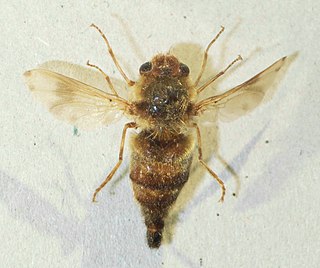
Gasterophilus intestinalis, also known as horse bot fly, is a species of insect of the family Oestridae, and is found worldwide. The adults, which have a bumblebee-like appearance, are prominently active in the summer. G. intestinalis is primarily a parasite of horses, mules and donkeys.
Dendroctonus adjunctus, the roundheaded pine beetle, is a species of bark beetle in the family Curculionidae found in North America. A parasite, the roundheaded pine beetle feeds on and eventually kills pine trees of several species in Guatemala, Mexico, and the Southern United States.



















